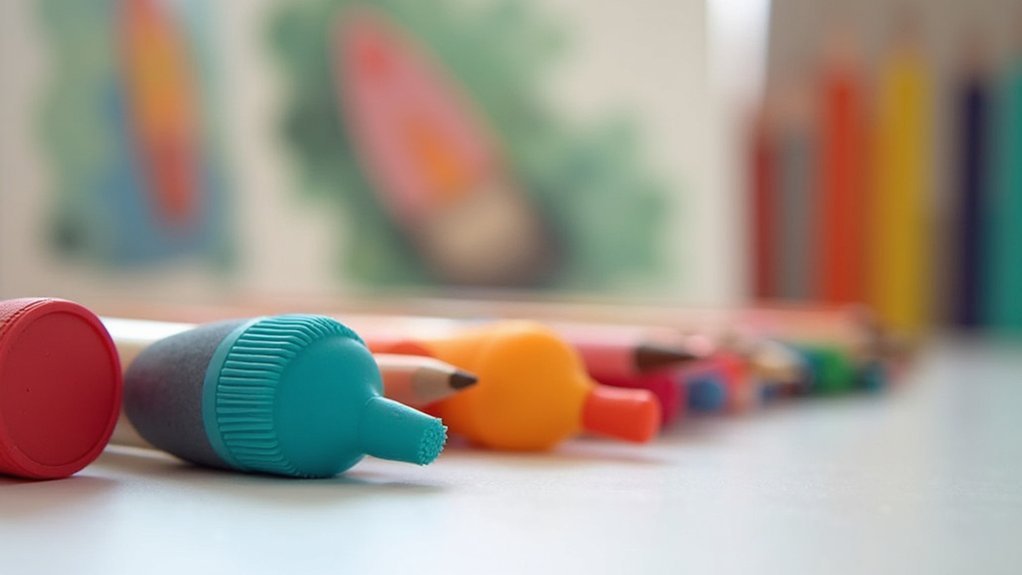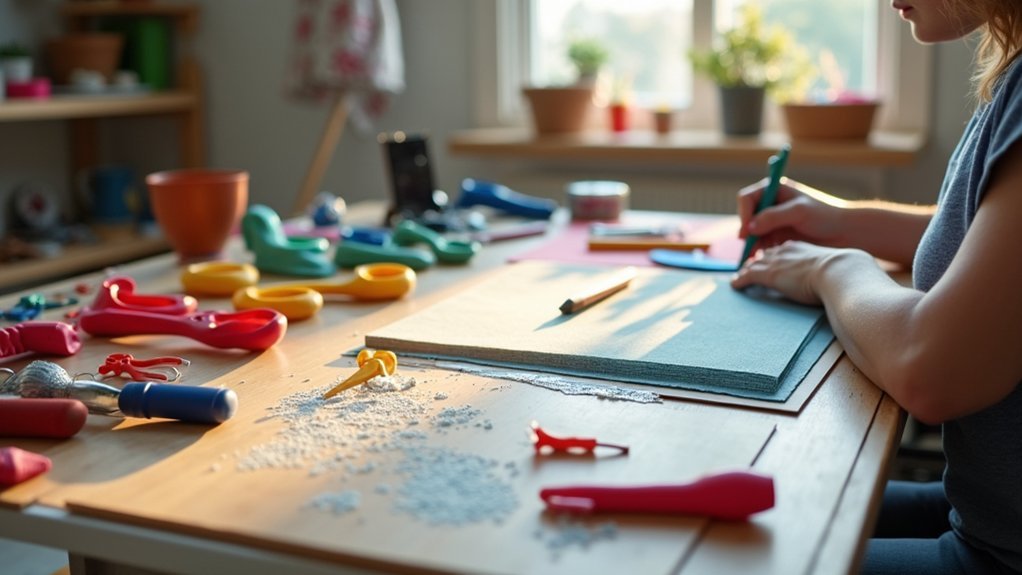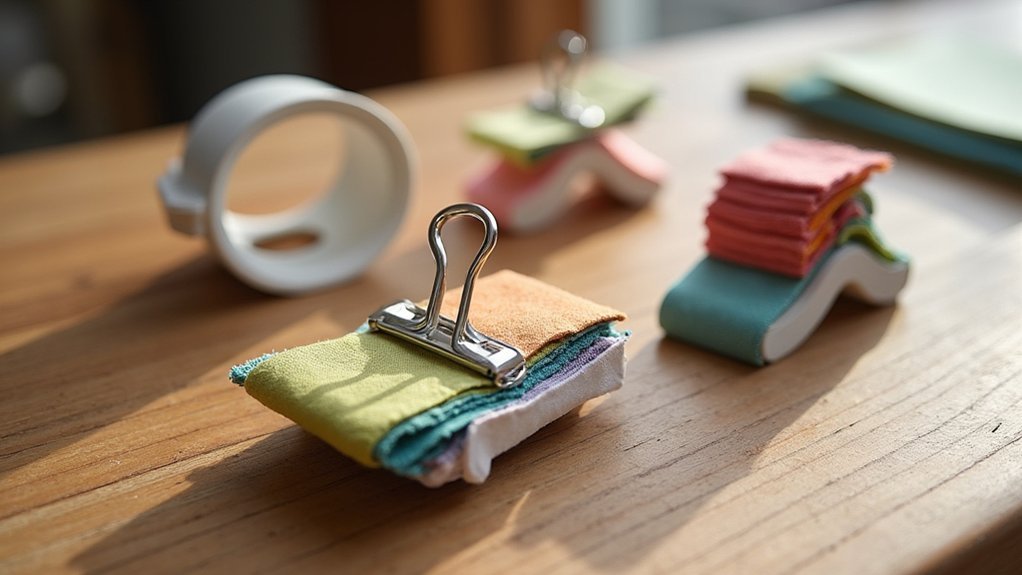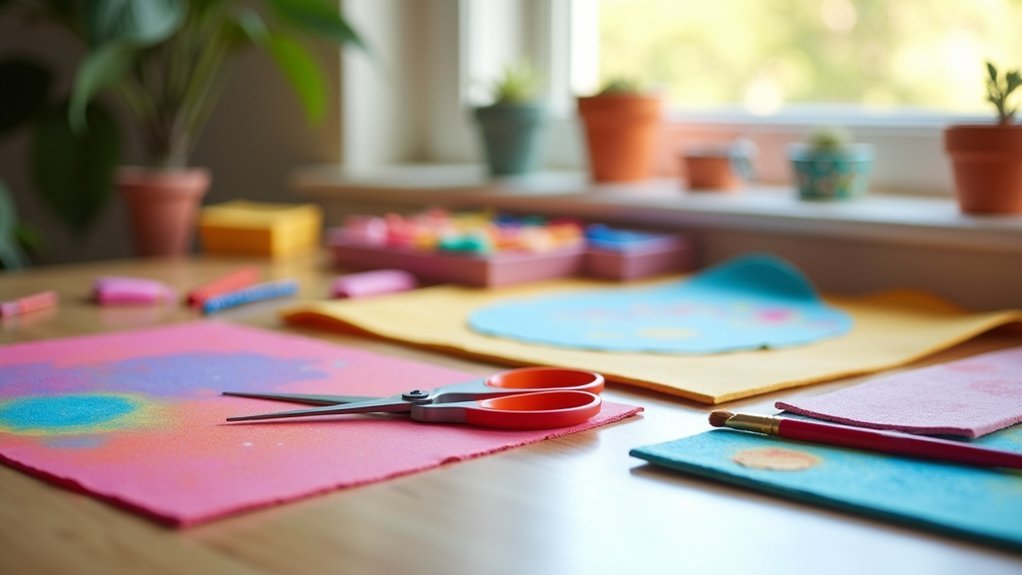Disabled makers can enhance their crafting experience with these DIY adaptive tools: ergonomic grip enhancers made from foam tubing, tabletop scissors requiring minimal strength, customizable angled work surfaces, low-cost material holders using zip ties or binder clips, sensory-friendly implements with rubberized grips, modified textile tools with enlarged handles, and multi-purpose extensions for various implements. These simple adaptations reduce strain, improve control, and foster independence while creating. Discover how these accessible solutions can transform your creative possibilities.
Ergonomic Grip Enhancers for Painting and Drawing Tools

When your hands struggle with strength or dexterity challenges, creating art shouldn’t be out of reach. Adaptive tools like pencil grippers and foam tubing can transform standard art supplies into disability-friendly instruments that enhance control and stability while reducing hand fatigue.
Consider textured paintbrushes with specialty handles for secure gripping during your creative expressions. Triangular crayons and jumbo art supplies require less precise movement, making them ideal if you have limited hand strength.
Art flows more freely when your tools work with your body, not against it. Adaptive supplies make creativity accessible to all hands.
For a budget-friendly option, customize your existing painting and drawing tools with rubber bands or self-adhering bandage wraps. These ergonomic grip enhancers improve handling greatly, allowing you to focus on your creativity rather than discomfort.
With the right adaptive tools, you’ll find that artistic pursuits remain accessible regardless of dexterity challenges.
Adaptive Cutting Solutions for Limited Hand Dexterity
Cutting with precision presents unique challenges for crafters with limited hand dexterity, but specialized tools now make these tasks accessible.
These adaptive cutting solutions reduce hand fatigue while improving accuracy in your DIY projects.
- Peta Easi-Grip Push-Down Table-Top Scissors feature a T-shaped handle that requires minimal finger strength—perfect for arthritis sufferers.
- Nimble One-Finger Cutting Tool fits on your fingertip for cutting paper, card, and thread with limited hand function.
- Foam grip tubing applied to scissors enhances control and improves grip for those struggling with traditional handles.
- Self-Adhering Bandage Wrap creates custom solutions by providing a non-slip surface around cutting tools.
- Ergonomic designs like loop or tabletop adaptive scissors enhance accessibility by requiring less coordination.
These DIY assistive technology solutions transform frustrating cutting tasks into enjoyable creative experiences.
Customizable Work Surfaces and Positioning Aids

You’ll find significant relief from crafting discomfort by creating simple DIY work surface solutions tailored to your specific needs.
Constructing an adjustable angle board from a wooden cutting board and hinged supports can position your materials at the perfect height and angle for your comfort.
Portable crafting stations made from lightweight materials such as foam-core boards or repurposed laptop trays allow you to enjoy your creative pursuits anywhere, whether in bed, a wheelchair, or your favorite armchair.
DIY Work Surface Solutions
Although many commercial crafting tables exist, creating your own customized work surface can better address specific accessibility needs while saving money.
Your DIY solutions can transform crafting experiences by reducing strain and improving stability.
- Add foam padding to table surfaces for improved grip and comfort during extended crafting sessions.
- Create an adjustable slant board using hinges and wooden boards to position materials at your ideal angle.
- Install non-slip surfaces (like shelf liner or silicone mats) to prevent materials from sliding during use.
- Attach clamps or weighted bases to your work surface to secure items when you have limited dexterity.
- Modify an existing table with adjustable height options using stackable risers or telescoping legs for ergonomic positioning whether sitting or standing.
Adjustable Angle Boards
Building on the DIY work surface concept, adjustable angle boards offer a specialized solution for disabled makers who need more control over their working position.
These customizable work surfaces can be tilted to various angles, helping you reduce strain on your neck and back while working on detailed crafting tasks.
If you have limited mobility, you’ll appreciate how these boards bring your work to you rather than forcing you to bend or reach.
Most models are lightweight and portable, allowing you to craft comfortably in different settings.
Look for boards with built-in clips or raised edges that secure materials in place, enhancing stability during your creative process.
These versatile tools support various activities from drawing to writing, promoting inclusivity for disabled makers by adapting to your specific needs and preferences.
Portable Crafting Stations
Three essential elements make portable crafting stations a game-changer for disabled makers: mobility, adaptability, and independence.
You’ll find these customizable work surfaces transform any space into your creative hub while addressing accessibility needs.
- Create your station using trays, tables, or lap desks for stable crafting activities anywhere
- Add non-slip materials or foam grip tubing to prevent tools from sliding during use
- Consider wheelchair-specific options like Trabasack that provide a secure workspace
- Improve ergonomics with slant boards or easels that position work at comfortable angles
- Incorporate positioning aids like adjustable height tables to accommodate your mobility level
These adaptations guarantee you’ll craft comfortably without strain on your neck and back during extended sessions.
Your portable station becomes a personalized tool that travels with you, maintaining independence wherever inspiration strikes.
Low-Cost Material Holders and Stabilizers

While creating art with limited mobility presents unique challenges, you don’t need expensive adaptive equipment to stabilize your materials. Zip ties create secure loops to hold crafting materials in place, offering remarkable stability for mere pennies.
Transform ordinary tools into adaptive devices by wrapping foam grip tubing around handles—instantly improving your grip with minimal investment.
Self-adhering bandage wrap provides another versatile solution; it creates non-slip surfaces on tools you already own. Repurpose plastic containers to organize and stabilize small items during your creative sessions.
Don’t overlook binder clips as temporary holders for papers, fabrics, or connecting materials while you work.
These low-cost solutions deliver impressive results without breaking your budget, proving that effective adaptations don’t require specialized equipment—just creative thinking and common household items.
Sensory-Friendly Crafting Implements
You’ll discover how texture-rich grips transform standard crafting tools into accessible options for hands with varying sensory needs.
Adding foam tubing or silicone grip aids to paintbrushes and pens provides both comfort and control while reducing hand fatigue during extended crafting sessions.
Light-touch material tools, including low-resistance scissors and pressure-sensitive styluses, allow you to create with minimal physical exertion while still enjoying tactile feedback.
Texture-Rich Grip Options
For many disabled makers, standard crafting tools present significant challenges that can be overcome with thoughtfully designed texture-rich grip options.
These adaptive art supplies transform your crafting experience by reducing hand fatigue and improving control during creative activities.
- Foam tubing easily slides over pencils, brushes, and tools to create cushioned surfaces for those with limited dexterity.
- Self-adhering bandage wraps provide customizable thickness and texture that conforms to your unique grip needs.
- Rubberized grips offer tactile elements that provide sensory feedback while maintaining stability.
- Easy-grip tools with specialized handles reduce strain during extended crafting sessions.
- The Functionalhand universal grip aid supports independent tool use, accommodating various implements while requiring minimal hand strength.
These texture-rich modifications enable you to craft comfortably despite motor challenges, allowing your creativity to flourish.
Light-Touch Material Tools
Crafting with sensory-friendly implements transforms the making experience because these specialized tools prioritize comfort without sacrificing functionality.
Light-touch material tools like soft grip paintbrushes with foam tubing provide the support you need when your hand strength is limited.
You’ll find textured paintbrushes particularly helpful for enhanced tactile feedback, giving you better control over your artistic expression while accommodating sensory sensitivities.
Jumbo crayons eliminate the need for precise motor skills, making color work accessible regardless of dexterity challenges.
Adaptive scissors with ergonomic handles reduce fatigue during cutting tasks, empowering you to craft independently.
These easy-to-hold designs and lightweight materials represent a significant step toward inclusivity and accessibility in the maker community.
When you choose sensory-friendly crafting tools, you’re not compromising on creativity—you’re enhancing it.
Modified Textile and Fiber Art Tools
When traditional knitting needles and crochet hooks become difficult to manage, modified textile and fiber art tools can reopen creative possibilities for disabled makers.
These adaptive art tools offer personalized solutions for anyone facing fine motor difficulties.
Customized craft tools create pathways to creativity when standard equipment presents barriers.
- Ergonomic knitting needles feature enlarged handles and lightweight designs to reduce hand strain while maintaining precision.
- Adaptive scissors with cushioned handles and easy-open mechanisms make fabric cutting accessible again.
- Foam tubing slipped over tool handles provides better grip and comfort during extended crafting sessions.
- Textured grip paintbrushes guarantee secure handling for detailed fiber art techniques.
- Weighted tools like yarn and fabric weights stabilize materials so you don’t need to apply excessive pressure.
These modified textile tools transform frustrating experiences into enjoyable creative sessions, allowing you to continue pursuing your fiber art passions.
Multi-Purpose Adaptive Handles and Extensions
Beyond specialized textile tools, many disabled crafters find that multi-purpose adaptive handles and extensions offer remarkable versatility across their creative practices.
You can customize these grip aids using foam tubing and self-adhering bandage wrap to enhance comfort for your limited hand strength or dexterity challenges.
Lightweight extensions attached to scissors or paintbrushes allow you to maintain better control during crafting activities.
Try utilizing zip ties and hook-and-loop fasteners to create adjustable handle grips perfectly tailored to your specific needs.
These versatile tools easily adapt to various implements—from kitchen utensils to art supplies—making them practical for both creative projects and daily living tasks.
The ergonomic designs of these adaptive handles greatly reduce strain and fatigue, enabling you to enjoy longer crafting sessions without discomfort.
Frequently Asked Questions
What Is the Most Innovative Tool Created for Disabled People?
Among innovations for disabled individuals, you’ll find the Nimble One-Finger Cutting Tool most revolutionary. It fits directly on your fingertip, allowing you to cut materials safely when you’ve got limited hand function.
What Tools Do Disabled People Use?
You’ll find disabled people using adaptive tools like pencil grippers, foam tubing, ergonomic scissors, textured paintbrushes, jumbo art supplies, wheelchair lap trays, and one-finger cutting tools to navigate daily tasks independently.
What Are Easy Crafts for Disabled Hands?
You’ll find painting with adaptive brushes, making collages with pre-cut materials, and creating sensory crafts with textured fabrics are all excellent options for disabled hands. Try using foam grip tools for easier handling.
What Equipment Is Used by Disabled People?
You’ll find disabled people using adaptive grips, ergonomic scissors, weighted utensils, universal cuffs, voice-activated technology, screen readers, mobility aids, and specialized switches to navigate daily activities with greater independence and comfort.
In Summary
DIY crafting shouldn’t be limited by disability. You’ve now got seven practical options to modify your creative toolkit. Whether you’re dealing with motor challenges, sensory sensitivities, or mobility issues, these adaptive solutions can help you express yourself without frustration. Remember, the best adaptations are the ones that work for your specific needs—don’t hesitate to customize these ideas further as you discover what works best for your creative practice.





Leave a Reply